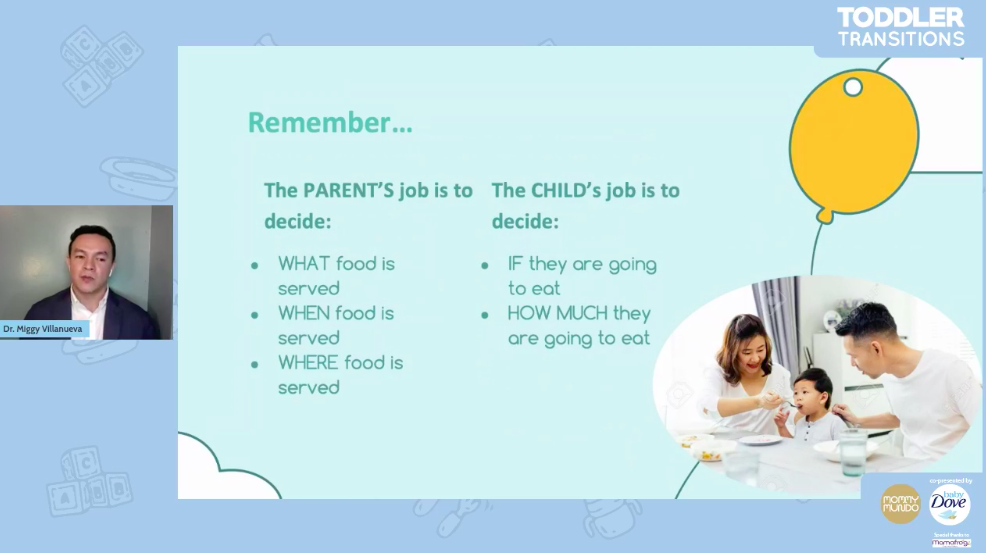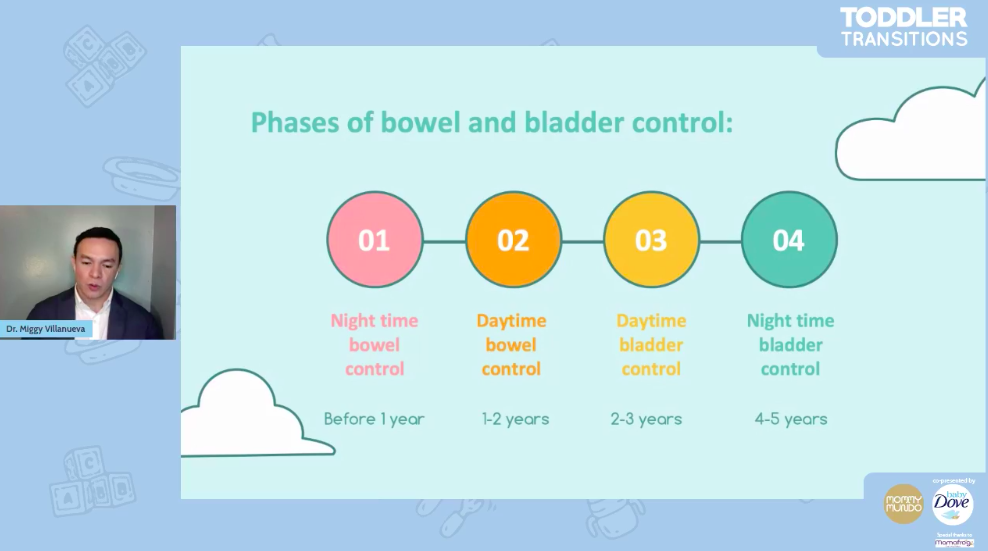by jojie garcia
Toddlerhood is such an exciting stage, not just for the wee ones finding their way in the world, but for their families as well! It’s full of all kinds of discoveries and challenges. As parents, we take on the task of being these children’s guides, doing our best to help our toddlers transition smoothly from change to change as they grow.
Thankfully, Mommy Mundo and #BabyDovePh always got our backs in this parenting journey by sharing with us valuable information from invited experts! Last February 11, 2021, Dr. Miggy Villanueva discussed two of the most challenging transitions that our toddlers go through, milk-to-meals weaning and potty-training, in his talk “Toddler Transitions: Tips and Tricks for your Tiny Tots”. Dr. Villanueva is a general pediatrician trained in allergy and clinical immunology, and here are some of his most helpful reminders in helping our toddlers gain confidence in their mealtime and potty routines!
From Milk to Meals: The Basics of Toddler Treats
– Timing is everything! With readiness cues from your child and your pediatrician’s guidance, you may gradually introduce different kinds of food in key moments of your baby’s growth. Pureed food may be given at 4-6 months, finger food at 8 months, lumped/chopped food at 10 months, and table food around their first birthday.
– Healthy food please! Start off your baby’s food journey with fruits and vegetables, making sure to give different kinds in intervals so you can observe any allergic reactions. And, no to sugar and salt before two years old! We want the kids to appreciate the food’s natural taste and texture.
– Make mealtimes something to look forward to! We can help our toddlers anticipate mealtimes by setting consistent meal schedules, and being fully present as they eat. Talk to them about their food! Make yummy sounds, or sing silly songs. Avoid distractions like gadgets that may become crutches in the long run. (This rule goes for you too, mom!) Finally, refrain from forcing them to eat their food, and instead provide workable choices that they can practice their agency on. For example, if they cannot finish everything, make them choose what to eat and do “magic” on — can they make the rice disappear, or the veggies?
– “Our toddlers are not terrorists”, Dr. Villanueva reminded us with humor. We must not feel like we should always give in to their demands in the dining table. To avoid this power struggle, he reminded us what kinds of power grown-ups and children hold during mealtimes. If you know that you’ve provided them the appropriate environment and wise choices in their plate, then you don’t need to sweat the small stuff.

– Bye bye bottle! While you are setting consistent mealtime practices, you may start weaning your child off the breast or bottle. Start during the daytime until they can say goodbye to their night feeding. You may offer a comfort toy or blankie that they can hold as you give them their milk in a special cup of their choice. Be there for them and give extra cuddles when they express longing for the bottle, however heartbreaking this separation may be. Dr. Villanueva warned of the disadvantages of prolonged bottle feeding like poor dentition, anemia, and obesity— and we certainly don’t want those!
Potty Training 101: Toddler Pains Into Toddler Gains
– Don’t fret, they will get there! Dr. Villanueva shared the phases of bladder and bowel control, and it was such an eye-opener! We sometimes put too much pressure on ourselves and the kids during potty training, when in fact it involves a number of bodily functions that take time to master. With our guidance, our kids will eventually be able to do it!

– Take cues from the kids! We can look out for physical, emotional, and cognitive readiness that let us know that they’re ready for the potty! These may be non-verbal cues like going to a special corner when they relieve themselves, when they develop an aversion for wet nappies, or when they actually say their bathroom words like “wiwi!”. Sometimes, they signal that they are ready by showing an interest in the bathroom (especially when Mom is using it, right?), and they aren’t scared of the flush or the faucet anymore.
– Potty green light tips: dress for potty success, get them a sturdy and comfortable potty (whether a kiddie-sized one or a potty attachment to your bowl), and keep them motivated! You may use rewards like stickers at first, and then phase it out as they let their inner motivation (aka nature’s calls) take over.
– Focus on the strides, not the accidents! When you potty train, use positive phrases like “Wow, you pulled your pants down by yourself!” or “You almost made it this time, yay!”. Avoid shaming your child when they soil themselves, and provide genuine encouragement that they can do better next time.
Thanks, Doc Miggy, for such a great talk on toddler transitions! You certainly reminded us Mommy Mundo moms that our tiny toddlers aren’t terrible, tenacious maybe, but they are simply in a stage where they need a lot of care, reassurance, and guidance.

about the contributor
Jojie Perocho-Garcia has been an educator for 14 years now. She keeps her quarantine days busy with preschool and high school tutorials, reading, watching Kdramas, and being MamaJie to her husband Jeb and kids Alba (4yo) and Rogo (1yo). You may find her on Instagram and Facebook as @teachmomsy where she shares education tips, parenting reflections, and homeschooling highlights.

Leave a Reply